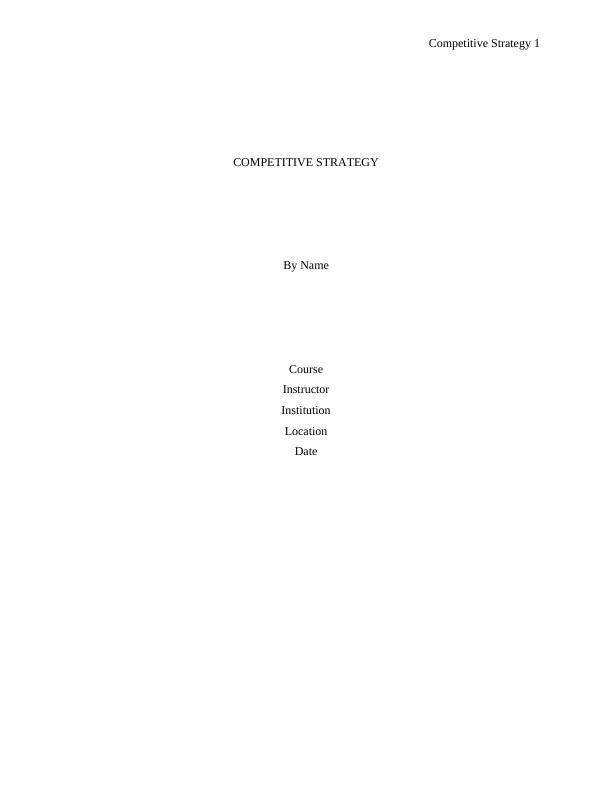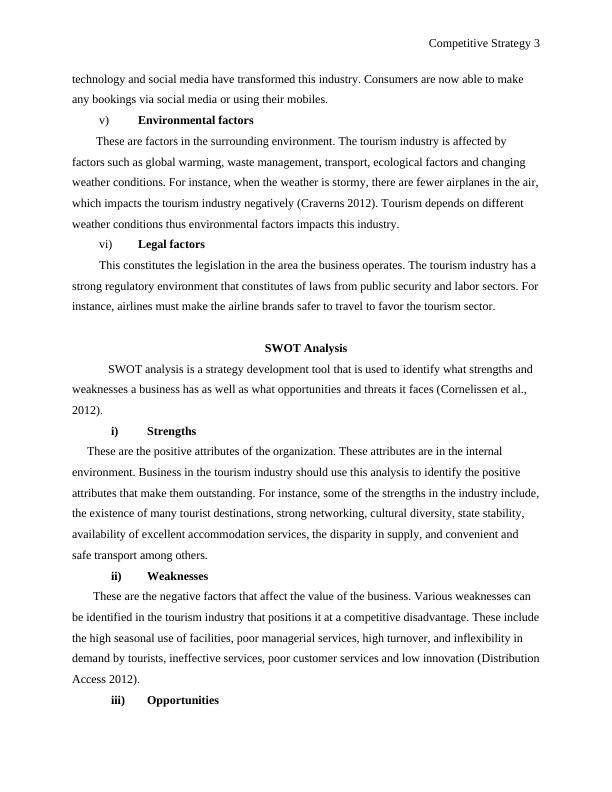Competitive Strategy: Tools for Effective Strategizing in the Tourism Industry
Added on 2023-06-12
7 Pages1867 Words196 Views
Competitive Strategy 1
COMPETITIVE STRATEGY
By Name
Course
Instructor
Institution
Location
Date
COMPETITIVE STRATEGY
By Name
Course
Instructor
Institution
Location
Date

Competitive Strategy 2
Introduction
Business strategic planning encompasses evaluating potential internal and external
factors that affect operations and establishing methods on how to cope with the effects. There are
some aspects to consider in the evaluation process such as competitive aspects, organizational
advantage, and customer needs. Various strategy development tools can be used to ensure
effective strategizing in the tourism business industry.
Pestel Analysis
This is a strategic development tool used to analyze the macro factors affecting business.
This involves assessing the environment in which a business operates.
i) Political factors
These factors include government and policies or regulations by the state that may affect
the business. Political factors have a significant impact on the tourism industry globally.
Terrorism and changing governments play a huge role in the tourism environment sector.
Tourism largely depends on peace from the government. For instance, the tourism sector in
Europe is doing well do to political stability in the region (Leite et al., 2017).
ii) Economic factors
These are factors that affect the economy, which leads to impacts on the business. They
include operational cost foreign exchange rates, the stability of the global economy and interest
rates. The tourism industry is primarily affected by economic factors. The labor market, as well
as consumer spending, mainly affect the tourism industry. The demand for hotels in a country is
a factor that positively affects the tourism factor.
iii) Social factors
Social factors include social trends that enhance the knowledge of customer wants. The
tourism industry social factors include consumer preferences; for example, more customers are
now opting for private accommodation, such as Air BnB rather than hotels.
iv) Technological factors
These factors involve technological innovation that affects the business. Technological
factors play a huge role in the growth of the tourism industry. There is increased communication
among countries due to technological innovation thus affecting the tourism industry. Mobile
Introduction
Business strategic planning encompasses evaluating potential internal and external
factors that affect operations and establishing methods on how to cope with the effects. There are
some aspects to consider in the evaluation process such as competitive aspects, organizational
advantage, and customer needs. Various strategy development tools can be used to ensure
effective strategizing in the tourism business industry.
Pestel Analysis
This is a strategic development tool used to analyze the macro factors affecting business.
This involves assessing the environment in which a business operates.
i) Political factors
These factors include government and policies or regulations by the state that may affect
the business. Political factors have a significant impact on the tourism industry globally.
Terrorism and changing governments play a huge role in the tourism environment sector.
Tourism largely depends on peace from the government. For instance, the tourism sector in
Europe is doing well do to political stability in the region (Leite et al., 2017).
ii) Economic factors
These are factors that affect the economy, which leads to impacts on the business. They
include operational cost foreign exchange rates, the stability of the global economy and interest
rates. The tourism industry is primarily affected by economic factors. The labor market, as well
as consumer spending, mainly affect the tourism industry. The demand for hotels in a country is
a factor that positively affects the tourism factor.
iii) Social factors
Social factors include social trends that enhance the knowledge of customer wants. The
tourism industry social factors include consumer preferences; for example, more customers are
now opting for private accommodation, such as Air BnB rather than hotels.
iv) Technological factors
These factors involve technological innovation that affects the business. Technological
factors play a huge role in the growth of the tourism industry. There is increased communication
among countries due to technological innovation thus affecting the tourism industry. Mobile

Competitive Strategy 3
technology and social media have transformed this industry. Consumers are now able to make
any bookings via social media or using their mobiles.
v) Environmental factors
These are factors in the surrounding environment. The tourism industry is affected by
factors such as global warming, waste management, transport, ecological factors and changing
weather conditions. For instance, when the weather is stormy, there are fewer airplanes in the air,
which impacts the tourism industry negatively (Craverns 2012). Tourism depends on different
weather conditions thus environmental factors impacts this industry.
vi) Legal factors
This constitutes the legislation in the area the business operates. The tourism industry has a
strong regulatory environment that constitutes of laws from public security and labor sectors. For
instance, airlines must make the airline brands safer to travel to favor the tourism sector.
SWOT Analysis
SWOT analysis is a strategy development tool that is used to identify what strengths and
weaknesses a business has as well as what opportunities and threats it faces (Cornelissen et al.,
2012).
i) Strengths
These are the positive attributes of the organization. These attributes are in the internal
environment. Business in the tourism industry should use this analysis to identify the positive
attributes that make them outstanding. For instance, some of the strengths in the industry include,
the existence of many tourist destinations, strong networking, cultural diversity, state stability,
availability of excellent accommodation services, the disparity in supply, and convenient and
safe transport among others.
ii) Weaknesses
These are the negative factors that affect the value of the business. Various weaknesses can
be identified in the tourism industry that positions it at a competitive disadvantage. These include
the high seasonal use of facilities, poor managerial services, high turnover, and inflexibility in
demand by tourists, ineffective services, poor customer services and low innovation (Distribution
Access 2012).
iii) Opportunities
technology and social media have transformed this industry. Consumers are now able to make
any bookings via social media or using their mobiles.
v) Environmental factors
These are factors in the surrounding environment. The tourism industry is affected by
factors such as global warming, waste management, transport, ecological factors and changing
weather conditions. For instance, when the weather is stormy, there are fewer airplanes in the air,
which impacts the tourism industry negatively (Craverns 2012). Tourism depends on different
weather conditions thus environmental factors impacts this industry.
vi) Legal factors
This constitutes the legislation in the area the business operates. The tourism industry has a
strong regulatory environment that constitutes of laws from public security and labor sectors. For
instance, airlines must make the airline brands safer to travel to favor the tourism sector.
SWOT Analysis
SWOT analysis is a strategy development tool that is used to identify what strengths and
weaknesses a business has as well as what opportunities and threats it faces (Cornelissen et al.,
2012).
i) Strengths
These are the positive attributes of the organization. These attributes are in the internal
environment. Business in the tourism industry should use this analysis to identify the positive
attributes that make them outstanding. For instance, some of the strengths in the industry include,
the existence of many tourist destinations, strong networking, cultural diversity, state stability,
availability of excellent accommodation services, the disparity in supply, and convenient and
safe transport among others.
ii) Weaknesses
These are the negative factors that affect the value of the business. Various weaknesses can
be identified in the tourism industry that positions it at a competitive disadvantage. These include
the high seasonal use of facilities, poor managerial services, high turnover, and inflexibility in
demand by tourists, ineffective services, poor customer services and low innovation (Distribution
Access 2012).
iii) Opportunities

End of preview
Want to access all the pages? Upload your documents or become a member.
Related Documents
Airline Industry: A Case Analysislg...
|7
|1616
|72
Air Asia Berhad Report 2022lg...
|13
|3546
|10
Strategic Tools for Analyzing Garuda Indonesia's Competitive Strategylg...
|5
|1631
|69
Strategy Development Tools for Tourism Industrylg...
|6
|1849
|92
Strategic Marketing for Vodafone Broadband Productlg...
|6
|1473
|63
Business Environment Assignment - Travel & Leisure sectorlg...
|8
|2315
|416
